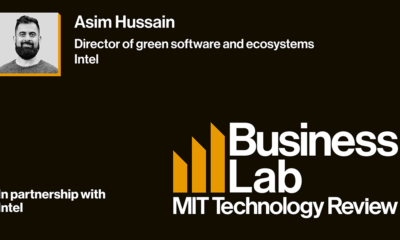Politics
6 Software Solutions Your B2B Company Needs in Its Tech Stack – ReadWrite
Published
3 years agoon
By
Drew Simpson
Communication and collaboration between departments and teams are essential for efficiency and success. While each team member has an individual job and departments carry out different functions, they can’t work in a vacuum.
Software Solutions Your B2B Company Needs
Client-based applications may have been sufficient in the past. But with the need for instantaneous, anytime, anywhere data sharing, cloud-based solutions can streamline your operations.
Cloud services fall under various categories. Software as a service, or SaaS, is the best known. However, other models such as integration platform as a service, or IPaaS, are providing new capabilities. An IPaaS lets you integrate local and cloud applications. You can create and implement ways to seamlessly transfer data back and forth between the two.
The following 6 software solutions can optimize everything from app integration and secure document sharing to task automation and security training.
Read on to discover the cloud-based services your business needs in its tech stack.
1. Workato
Workato is a business automation platform that connects the multiple applications your company uses. Your B2B organization can develop customized workflows and automate them. Unlike with a traditional IPaaS, you don’t need the IT folks to create these processes.
The platform doesn’t require knowledge of complicated coding in order to automate and optimize workflows.
That means employees that work in non-technical roles like marketing and finance can use Workato, too. There are AI chatbots for easy and constant access to data across departments. Gartner has recognized Workato as a market leader in the enterprise IPaaS arena for three consecutive years.
2. CapLinked
Businesses can securely upload, share, and collaborate on deal-related documents with CapLinked. What makes this tool so versatile is that you can create and manage different virtual workspaces. Set up one space with documents that pertain to supplier contracts, then create another space for internal strategic marketing plans.
CapLinked has built-in communication features, including editing and deadline alerts, email updates, FAQ notifications, and instant messaging. You can also set and change access at the file or workspace level as employees and contacts change. To make this process simpler, you can create and manage groups from contact lists.
Implement extra layers of security by requiring logins to open downloaded files. These permissions can be taken away as needed, along with viewing and printing abilities. You can also enable watermarking if desired. And rest assured that CapLinked’s servers are SSAE 18 and ISO 27001 certified; the platform is also HIPAA and SOC 2 compliant.
3. Stampli
Stampli is an accounts payable automation solution. This platform connects to the accounting system your company already uses. Stampli can read invoices as they come in and learn how to code and send them through for approval. With built-in AI, this tool automatically detects duplicates, makes calculations, and provides purchase order support.
Communication about invoices happens right in the application. If there are questions about whether a department received products or services, they can be easily answered. This can help make the approval process more efficient and accurate.
Security, auditing, and payments are controllable from within the dashboard. You can set permissions for employee access to invoices and information. Payments can go out through your existing process, or you can use Stampli Direct Pay. All direct-pay transactions are done via the Automated Clearing House, or ACH, making reconciliation time, less of a headache.
4. Paycom
Paycom is a SaaS human resources solution that can manage workflows related to attracting new employees, developing existing ones, running payroll, and delivering benefits. The talent acquisition piece automates online job postings, candidate tracking, and onboarding for new hires. Your HR team won’t have to re-enter successful candidate data for background checks, tax credits, or I-9 verifications.
Performance reviews, goals, and expectations for current team members fall under Paycom’s talent management dashboard. Supervisors can work with HR to determine skills and requirements for positions, in addition to salaries. If desired, employees can complete 360-degree reviews for peers and self-evaluations.
The payroll function integrates regular paychecks, expense report reimbursements, and garnishments. Any changes to federal and local state payroll tax laws will be reflected in the software. Accounting reports for general ledger purposes can be customized and automated.
Paycom lets your team members see their elected benefits and how making changes to insurance plans would impact their deductions. They can change their insurance coverage from the application and ask any questions they might have.
5. Salesforce
Salesforce is a cloud-based customer relationship management platform. It has individualized solutions for industries that deal with B2B clients, such as telecom, financial services, and manufacturing. Up-and-coming businesses can choose Salesforce’s small business solutions to help manage growth. Sales, marketing, service, tech, and e-commerce teams can work together to nurture leads and clients.
Each function’s team is able to see the same data about your company’s customers. When customer service reports repeat problems with a client’s experience, account executives will know not to push more products for now. Salesforce has various apps to coincide with the buyer’s journey, from initial interest to repeat business. All departments can analyze identical trends to identify strengths and opportunities to retain and increase market share.
For your staff, Salesforce offers Einstein AI. This is a built-in tool that takes care of repetitive tasks so your team can concentrate on the meaningful parts of their jobs. Whether employees are in the office or working remotely, they can communicate and collaborate effectively with each other. Customer records, reports, plans, and discussions can all be found in one location.
6. KnowBe4
CompTIA reports that phishing scams contribute to 80% of security incidents in organizations. As hackers develop more sophisticated emails and texts, employees can be tricked into giving away confidential information.
KnowBe4 trains your staff to recognize phishing, domain spoofs, and social engineering exploits. The application can identify weak passwords, twin domains, and whether your current network security measures can block ransomware attacks.
These capabilities can pinpoint weaknesses in your company’s security and employees’ knowledge. KnowBe4 can scale according to how many employees you have. Or if your company handles network security for others, you can use the channel partnership package.
As an automated training solution, KnowBe4 increases your team’s awareness of attackers’ methods. Employees learn through simulated attacks, and you get to see the results so you can track the training’s effectiveness. Over time, your organization becomes more secure by teaching staff what to do with suspicious emails or links.
Conclusion
Your B2B company needs these software solutions in its tech stack
Hosting application after application on local servers is no longer practical. It’s too easy to run out of space and go over budget.
While your staff can access the same data using old-school methods, why risk miscommunication?
Cloud-based software solutions solve both problems while ensuring your company has the tools it needs to compete.
Image Credit: rasik; pexels; thank you!
Brad Anderson
Editor In Chief at ReadWrite
Brad is the editor overseeing contributed content at ReadWrite.com. He previously worked as an editor at PayPal and Crunchbase. You can reach him at brad at readwrite.com.
You may like
-


Developing climate solutions with green software
-


Yahoo’s decades-long China controversy and the responsibility of tech companies
-


Chinese apps are letting public juries settle customer disputes
-


Make no mistake—AI is owned by Big Tech
-


Climate tech is back—and this time, it can’t afford to fail
-


Your guide to talking about climate tech over the holidays
Politics
Fintech Kennek raises $12.5M seed round to digitize lending
Published
7 months agoon
10/11/2023By
Drew Simpson
London-based fintech startup Kennek has raised $12.5 million in seed funding to expand its lending operating system.
According to an Oct. 10 tech.eu report, the round was led by HV Capital and included participation from Dutch Founders Fund, AlbionVC, FFVC, Plug & Play Ventures, and Syndicate One. Kennek offers software-as-a-service tools to help non-bank lenders streamline their operations using open banking, open finance, and payments.
The platform aims to automate time-consuming manual tasks and consolidate fragmented data to simplify lending. Xavier De Pauw, founder of Kennek said:
“Until kennek, lenders had to devote countless hours to menial operational tasks and deal with jumbled and hard-coded data – which makes every other part of lending a headache. As former lenders ourselves, we lived and breathed these frustrations, and built kennek to make them a thing of the past.”
The company said the latest funding round was oversubscribed and closed quickly despite the challenging fundraising environment. The new capital will be used to expand Kennek’s engineering team and strengthen its market position in the UK while exploring expansion into other European markets. Barbod Namini, Partner at lead investor HV Capital, commented on the investment:
“Kennek has developed an ambitious and genuinely unique proposition which we think can be the foundation of the entire alternative lending space. […] It is a complicated market and a solution that brings together all information and stakeholders onto a single platform is highly compelling for both lenders & the ecosystem as a whole.”
The fintech lending space has grown rapidly in recent years, but many lenders still rely on legacy systems and manual processes that limit efficiency and scalability. Kennek aims to leverage open banking and data integration to provide lenders with a more streamlined, automated lending experience.
The seed funding will allow the London-based startup to continue developing its platform and expanding its team to meet demand from non-bank lenders looking to digitize operations. Kennek’s focus on the UK and Europe also comes amid rising adoption of open banking and open finance in the regions.
Featured Image Credit: Photo from Kennek.io; Thank you!
Radek Zielinski
Radek Zielinski is an experienced technology and financial journalist with a passion for cybersecurity and futurology.
Politics
Fortune 500’s race for generative AI breakthroughs
Published
7 months agoon
10/11/2023By
Drew Simpson
As excitement around generative AI grows, Fortune 500 companies, including Goldman Sachs, are carefully examining the possible applications of this technology. A recent survey of U.S. executives indicated that 60% believe generative AI will substantially impact their businesses in the long term. However, they anticipate a one to two-year timeframe before implementing their initial solutions. This optimism stems from the potential of generative AI to revolutionize various aspects of businesses, from enhancing customer experiences to optimizing internal processes. In the short term, companies will likely focus on pilot projects and experimentation, gradually integrating generative AI into their operations as they witness its positive influence on efficiency and profitability.
Goldman Sachs’ Cautious Approach to Implementing Generative AI
In a recent interview, Goldman Sachs CIO Marco Argenti revealed that the firm has not yet implemented any generative AI use cases. Instead, the company focuses on experimentation and setting high standards before adopting the technology. Argenti recognized the desire for outcomes in areas like developer and operational efficiency but emphasized ensuring precision before putting experimental AI use cases into production.
According to Argenti, striking the right balance between driving innovation and maintaining accuracy is crucial for successfully integrating generative AI within the firm. Goldman Sachs intends to continue exploring this emerging technology’s potential benefits and applications while diligently assessing risks to ensure it meets the company’s stringent quality standards.
One possible application for Goldman Sachs is in software development, where the company has observed a 20-40% productivity increase during its trials. The goal is for 1,000 developers to utilize generative AI tools by year’s end. However, Argenti emphasized that a well-defined expectation of return on investment is necessary before fully integrating generative AI into production.
To achieve this, the company plans to implement a systematic and strategic approach to adopting generative AI, ensuring that it complements and enhances the skills of its developers. Additionally, Goldman Sachs intends to evaluate the long-term impact of generative AI on their software development processes and the overall quality of the applications being developed.
Goldman Sachs’ approach to AI implementation goes beyond merely executing models. The firm has created a platform encompassing technical, legal, and compliance assessments to filter out improper content and keep track of all interactions. This comprehensive system ensures seamless integration of artificial intelligence in operations while adhering to regulatory standards and maintaining client confidentiality. Moreover, the platform continuously improves and adapts its algorithms, allowing Goldman Sachs to stay at the forefront of technology and offer its clients the most efficient and secure services.
Featured Image Credit: Photo by Google DeepMind; Pexels; Thank you!
Deanna Ritchie
Managing Editor at ReadWrite
Deanna is the Managing Editor at ReadWrite. Previously she worked as the Editor in Chief for Startup Grind and has over 20+ years of experience in content management and content development.
Politics
UK seizes web3 opportunity simplifying crypto regulations
Published
7 months agoon
10/10/2023By
Drew Simpson
As Web3 companies increasingly consider leaving the United States due to regulatory ambiguity, the United Kingdom must simplify its cryptocurrency regulations to attract these businesses. The conservative think tank Policy Exchange recently released a report detailing ten suggestions for improving Web3 regulation in the country. Among the recommendations are reducing liability for token holders in decentralized autonomous organizations (DAOs) and encouraging the Financial Conduct Authority (FCA) to adopt alternative Know Your Customer (KYC) methodologies, such as digital identities and blockchain analytics tools. These suggestions aim to position the UK as a hub for Web3 innovation and attract blockchain-based businesses looking for a more conducive regulatory environment.
Streamlining Cryptocurrency Regulations for Innovation
To make it easier for emerging Web3 companies to navigate existing legal frameworks and contribute to the UK’s digital economy growth, the government must streamline cryptocurrency regulations and adopt forward-looking approaches. By making the regulatory landscape clear and straightforward, the UK can create an environment that fosters innovation, growth, and competitiveness in the global fintech industry.
The Policy Exchange report also recommends not weakening self-hosted wallets or treating proof-of-stake (PoS) services as financial services. This approach aims to protect the fundamental principles of decentralization and user autonomy while strongly emphasizing security and regulatory compliance. By doing so, the UK can nurture an environment that encourages innovation and the continued growth of blockchain technology.
Despite recent strict measures by UK authorities, such as His Majesty’s Treasury and the FCA, toward the digital assets sector, the proposed changes in the Policy Exchange report strive to make the UK a more attractive location for Web3 enterprises. By adopting these suggestions, the UK can demonstrate its commitment to fostering innovation in the rapidly evolving blockchain and cryptocurrency industries while ensuring a robust and transparent regulatory environment.
The ongoing uncertainty surrounding cryptocurrency regulations in various countries has prompted Web3 companies to explore alternative jurisdictions with more precise legal frameworks. As the United States grapples with regulatory ambiguity, the United Kingdom can position itself as a hub for Web3 innovation by simplifying and streamlining its cryptocurrency regulations.
Featured Image Credit: Photo by Jonathan Borba; Pexels; Thank you!
Deanna Ritchie
Managing Editor at ReadWrite
Deanna is the Managing Editor at ReadWrite. Previously she worked as the Editor in Chief for Startup Grind and has over 20+ years of experience in content management and content development.
